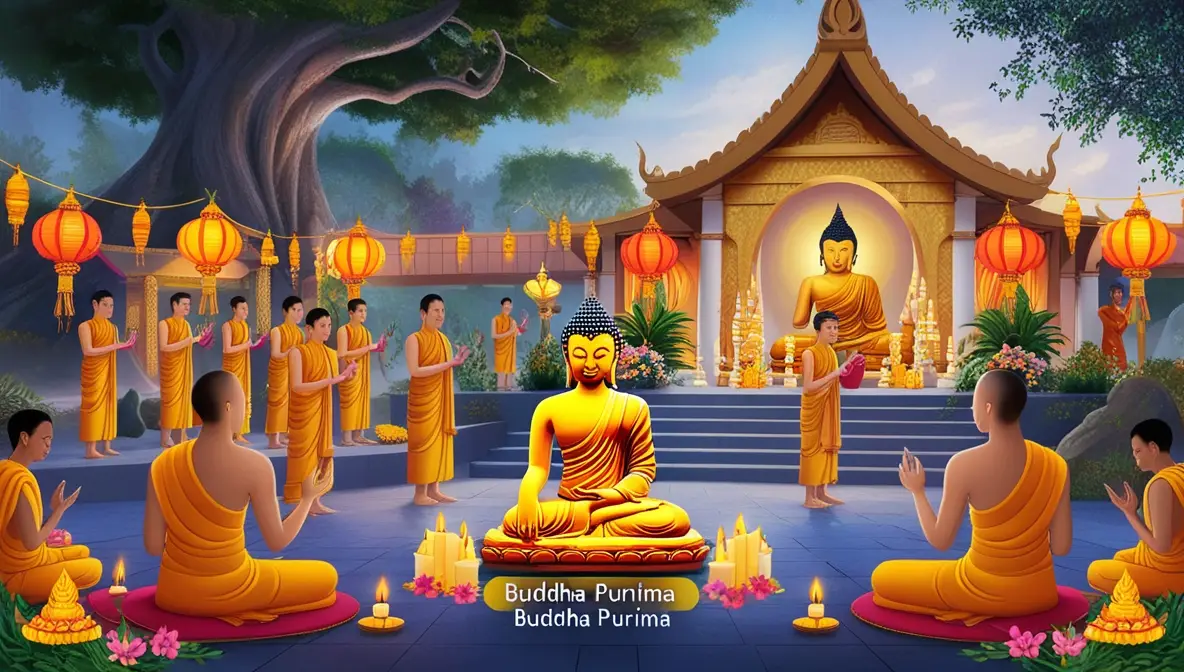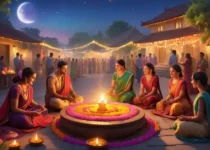Buddha Purnima
Buddha Purnima: A Sacred Day of Enlightenment and Compassion
Buddha Purnima, also known as Vesak or Buddha Jayanti, is a significant day in the Buddhist calendar. This auspicious occasion marks the birth, enlightenment, and death (Mahaparinirvana) of Gautama Buddha, the founder of Buddhism. Celebrated with deep reverence and devotion, Buddha Purnima is a day that embodies the essence of Buddhism—peace, compassion, and the pursuit of wisdom. In this article, we delve into the rich history, cultural significance, and diverse traditions associated with Buddha Purnima.

Understanding the Significance of Buddha Purnima
What is Buddha Purnima?
Buddha Purnima is celebrated on the full moon day in the month of Vaishakha (April or May) according to the Hindu calendar. This day is believed to be the most important in the Buddhist faith as it commemorates the three pivotal events in Buddha’s life: his birth, his enlightenment under the Bodhi tree, and his Mahaparinirvana.
The Historical Background
Gautama Buddha, born as Siddhartha Gautama in 563 BCE in Lumbini (modern-day Nepal), was a prince who renounced his worldly life to seek the truth about human suffering. After years of meditation and ascetic practices, he attained enlightenment at the age of 35 in Bodh Gaya, India. His teachings laid the foundation for Buddhism, one of the major religions in the world today.
The Spiritual Essence of Buddha Purnima
The celebration of Buddha Purnima is not just about paying homage to Buddha; it’s about embracing the core teachings of Buddhism. It is a day to reflect on the principles of non-violence, kindness, and self-realization. Followers believe that by practicing these virtues, they can attain Nirvana—the ultimate state of liberation from the cycle of birth and death.
How Buddha Purnima is Celebrated Across the World
India: The Birthplace of Buddha
In India, Buddha Purnima is celebrated with grandeur, especially in regions with a significant Buddhist population like Sarnath, Bodh Gaya, and Kushinagar. Devotees visit monasteries and temples, offer prayers, meditate, and participate in processions. The Mahabodhi Temple in Bodh Gaya, where Buddha attained enlightenment, becomes a focal point of the celebrations.
Nepal: The Land of Buddha’s Birth
Nepal, being the birthplace of Gautama Buddha, witnesses grand celebrations on Buddha Purnima. The city of Lumbini, which is a UNESCO World Heritage site, becomes a pilgrimage center where thousands gather to celebrate the life and teachings of Buddha. The rituals include chanting of sutras, lighting of lamps, and offerings of flowers and fruits.
Sri Lanka: Vesak Celebrations
In Sri Lanka, Buddha Purnima is known as Vesak, and it is the most important religious festival in the country. The celebrations last for a week and include various activities like almsgiving, parades, and the decoration of homes and streets with Vesak lanterns. The emphasis is on spreading the message of peace and harmony.
Southeast Asia: A Day of Merit
In countries like Thailand, Myanmar, and Cambodia, Buddha Purnima is observed with great devotion. Temples are adorned with lights, and people participate in religious ceremonies. The day is also marked by acts of merit, such as donating to the poor, releasing captive animals, and feeding the hungry.
Rituals and Practices Associated with Buddha Purnima
Visiting Temples and Monasteries
On Buddha Purnima, devotees flock to temples and monasteries to offer prayers and meditate. The atmosphere is filled with the chanting of sutras and the scent of incense. It is a time for spiritual renewal and introspection.
Offering of Dana (Charity)
One of the key practices on Buddha Purnima is Dana, the act of giving. Followers of Buddhism believe that by practicing generosity, they accumulate good karma. On this day, people donate food, clothes, and money to the needy, and monks go on alms rounds, collecting offerings from the community.
Observing the Five Precepts
Buddhists observe the Five Precepts on Buddha Purnima, which are ethical guidelines that form the foundation of Buddhist morality. These precepts include abstaining from killing, stealing, sexual misconduct, lying, and intoxication. Observing these precepts is seen as a way to purify the mind and soul.
Meditation and Chanting
Meditation plays a central role in the celebrations. Devotees spend time in deep meditation, reflecting on the teachings of Buddha. Chanting of Buddhist scriptures, especially the Dhammapada, is also a common practice, as it is believed to bring peace and clarity to the mind.
Lighting of Lamps
The lighting of lamps or candles is a symbolic act performed on Buddha Purnima. It represents the dispelling of ignorance and the illumination of the mind with wisdom. Temples and homes are adorned with lights, creating a serene and spiritual ambiance.
The Teachings of Buddha and Their Relevance Today
The Four Noble Truths
At the heart of Buddha’s teachings are the Four Noble Truths, which outline the nature of suffering and the path to liberation. These truths are as relevant today as they were over two millennia ago:
- The Truth of Suffering (Dukkha): Life is filled with suffering, whether it’s physical pain, emotional distress, or existential angst.
- The Truth of the Cause of Suffering (Samudaya): Suffering is caused by desire, attachment, and ignorance.
- The Truth of the End of Suffering (Nirodha): It is possible to end suffering by overcoming desire and attachment.
- The Truth of the Path to the End of Suffering (Magga): The path to liberation is the Noble Eightfold Path, which includes right understanding, right intention, right speech, right action, right livelihood, right effort, right mindfulness, and right concentration.
The Noble Eightfold Path
The Noble Eightfold Path is the practical guide to ethical and mental development with the goal of freeing the individual from attachments and delusions. It’s divided into three main categories: wisdom (right understanding and intention), ethical conduct (right speech, action, and livelihood), and mental discipline (right effort, mindfulness, and concentration).
The Concept of Nirvana
Nirvana is the ultimate goal in Buddhism—a state of perfect peace and liberation from the cycle of birth and rebirth. It is achieved by following the teachings of Buddha and leading a life of virtue and wisdom. On Buddha Purnima, followers renew their commitment to this spiritual path.
Modern-Day Reflections on Buddha Purnima
Buddhism in the Contemporary World
Buddhism, with its emphasis on mindfulness, compassion, and non-violence, offers valuable lessons for today’s fast-paced and often stressful world. The teachings of Buddha encourage us to live in harmony with others and to cultivate inner peace.
The Global Impact of Buddha Purnima
Buddha Purnima is not just a religious festival; it has become a global event that promotes the values of peace, compassion, and tolerance. People from different cultures and backgrounds come together to celebrate the teachings of Buddha, making it a day of unity and spiritual awakening.
Buddha Purnima and Environmental Awareness
In recent years, Buddha Purnima has also been associated with environmental awareness. The teachings of Buddha emphasize the interconnectedness of all living beings and the importance of living in harmony with nature. On this day, many communities organize tree-planting drives, clean-up campaigns, and other eco-friendly activities.
Buddha Purnima is a day of deep spiritual significance for millions of people around the world. It is a time to reflect on the profound teachings of Gautama Buddha and to recommit to a life of compassion, wisdom, and inner peace. Whether through meditation, acts of charity, or simply spending time in contemplation, Buddha Purnima offers an opportunity for personal and collective growth.
FAQs
1. Why is Buddha Purnima celebrated on a full moon?
Buddha Purnima is celebrated on a full moon day because it is believed that all three major events in Buddha’s life—his birth, enlightenment, and Mahaparinirvana—occurred on full moon days.
2. What are the Five Precepts observed on Buddha Purnima?
The Five Precepts are ethical guidelines that include abstaining from killing, stealing, sexual misconduct, lying, and intoxication. These are observed to purify the mind and soul.
3. How can I participate in Buddha Purnima if I’m not a Buddhist?
Anyone can participate in Buddha Purnima by visiting a local temple, engaging in acts of kindness, or simply spending time in meditation and reflection on the teachings of Buddha.
4. What is the significance of lighting lamps on Buddha Purnima?
Lighting lamps on Buddha Purnima symbolizes the dispelling of ignorance and the illumination of wisdom in one’s life.
5. How is Buddha Purnima connected to environmental awareness?
Buddha Purnima has increasingly become associated with environmental awareness, as the teachings of Buddha emphasize living in harmony with nature. Activities like tree planting and clean-up drives are often organized on this day.


